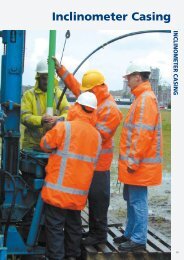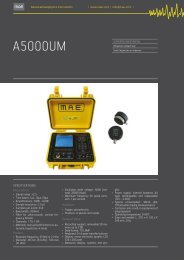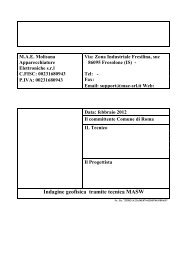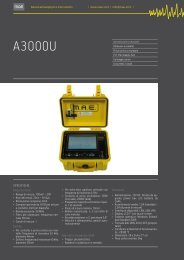Untitled
Untitled
Untitled
Create successful ePaper yourself
Turn your PDF publications into a flip-book with our unique Google optimized e-Paper software.
58<br />
MONITORING<br />
› NON-DESTRUCTIVE TESTS<br />
The Non Destructive Tests (NDT) consists<br />
in a series of assessments, tests<br />
and surveys carried out with methods<br />
that do not alter the material and do<br />
not require the destruction or removal<br />
of samples from the structure tested,<br />
aimed at finding and identifying structural<br />
defects of the same structure. The<br />
acronym NDT derived from the English<br />
expression Non Destructive Testing, is<br />
often used or acronym P.n.D., derived<br />
from Non Destructive tests (in Italian).<br />
In the industrial sector, each product<br />
of critical importance (beams for construction,<br />
support screws, aeronautical<br />
components, car components, pressure<br />
bodies) must be checked to assess<br />
its integrity and conformity with<br />
applicable laws. The primary objective<br />
of non destructive tests is therefore to<br />
foresee the cracking of materials and<br />
objects, thus covering an essential role<br />
to prevent economic damages due to<br />
possible accidents and also to guarantee<br />
a high level of safety for operators.<br />
Reinforced concrete structures<br />
(masonry), particularly important for<br />
their long-life and unlimited endurableness<br />
to continuous and uncontrollable<br />
changes, excluding disastrous<br />
events (earthquakes, thermal shocks,<br />
landslides, etc), ) in the majority of<br />
the cases showed phenomena of progressive<br />
deterioration during their life.<br />
These defects are linked to the executive<br />
phase of the works, aggressiveness<br />
of building materials (alkalis – silica<br />
reactions), micro-holes produced<br />
by water-thermal variations, sagging<br />
of foundations or grounds, static-dynamic<br />
operating stresses. The non invasive<br />
character of this method applicable<br />
to existing works allows to verify<br />
the physical and mechanical characteristics<br />
of the materials that constitute<br />
the structure.<br />
› MEASUREMENT OF HEAT TRANSMISSION ON SITE<br />
In building technology, the testing of<br />
the insulation capacity of building materials<br />
is an important topic of study. In<br />
addition to laboratory measurements<br />
of the thermal properties of materials,<br />
their behaviours is also studied through<br />
tests on field, in order to obtain information<br />
on the behaviours in different<br />
climates. The total heat flow through a<br />
material consists of a conductive, convective<br />
and radioactive part. In order to<br />
measure the heat transmission, a heat<br />
flow meter and some thermometers<br />
are used, assembled on both sides (interior<br />
and exterior) of a wall. After recording<br />
the flow and temperatures for<br />
a few hours, measured with high precision,<br />
the data is elaborated to obtain<br />
the average heat transmission of<br />
the wall.









